Samsung Galaxy S 6 and S 6 Edge: Preview
by Joshua Ho on March 26, 2015 9:00 AM EST- Posted in
- Smartphones
- Samsung
- Mobile
- Galaxy S6
- Galaxy S6 Edge
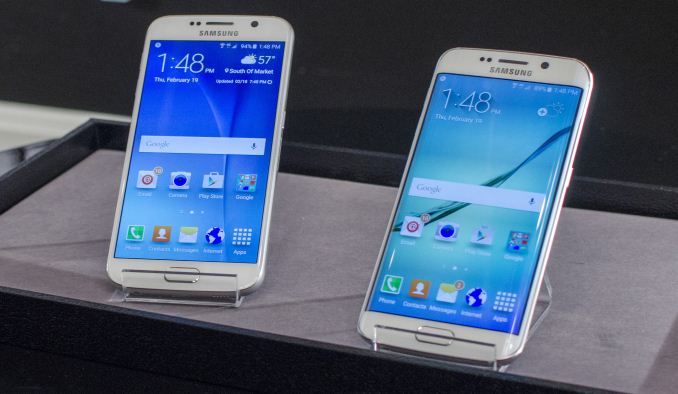
Yesterday we received our Galaxy S6 and S6 edge review units. We’re still working on the final review but I wanted to share some early results from both devices. For those that are unfamiliar with these two phones, the Galaxy S6 range represents the result of Samsung’s “Project Zero”. In fact, the phones seem to have the internal name of Zero, which can be seen in terminal, and the build properties of both devices. For Samsung, these phones represent their attempt at completely rethinking how Samsung makes phones. There is a strong emphasis on a new unibody design, which has no visible gaps or screws. Rather than the plastic that previous Samsung phones have been known for, the new design is composed of metal and glass. Samsung’s design team has been given unprecedented control throughout the process of making this phone and the result of this is a Galaxy phone that looks unlike anything else they’ve ever released.
Even if design is important, it isn’t enough to make the phone. Samsung has also outfitted the Galaxy S6 and S6 edge with their latest technologies, from a new AMOLED display to a new camera module. The specs for both phones can be seen below.
| Samsung Galaxy S5 | Samsung Galaxy S6 | Samsung Galaxy S6 Edge | |
| SoC | MSM8974ACv3 2.45 GHz Snapdragon 801 | Exynos 7420 2.1/1.5GHz A57/A53 | Exynos 7420 2.1/1.5GHz A57/A53 |
| RAM/NAND | 2GB LPDDR3 16/32GB NAND + microSD |
3GB LPDDR4-1552 32/64/128GB NAND |
3GB LPDDR4-1552 32/64/128GB NAND |
| Display | 5.1” 1080p SAMOLED HD |
5.1” 1440p SAMOLED |
5.1” 1440p SAMOLED, Dual Edge |
| Network | 2G / 3G / 4G LTE (Qualcomm MDM9x25 UE Category 4 LTE) | 2G / 3G / 4G LTE (Category 6 LTE) | 2G / 3G / 4G LTE (Category 6 LTE) |
| Dimensions | 142 x 72.5 x 8.1 mm, 145 grams | 143.4 x 70.5 x 6.8mm max, 138 grams | 142.1 x 70.1 x 7.0mm max, 132 grams |
| Camera | 16MP (5132 x 2988) Rear Facing with 1.12 µm pixels, 1/2.6" CMOS size, 31 mm (35mm effective), f/2.2 | 16MP (5132 x 2988) Rear Facing w/ OIS, f/1.9, object tracking AF | 16MP (5132 x 2988) Rear Facing w/ OIS, f/1.9, object tracking AF |
| 2MP Front Facing | 5MP Front Facing, f/1.9 | 5MP Front Facing, f/1.9 | |
| Battery | 2800 mAh (10.78 Whr) | 2550 mAh (9.81 Whr) | 2600 mAh (10.01 Whr) |
| OS | Android 4.4 w/TouchWiz |
Android 5 (64-bit) w/TouchWiz | Android 5 (64-bit) w/TouchWiz |
| Connectivity | 802.11a/b/g/n/ac 2x2 + BT 4.0 (BCM4354), USB3.0, GPS/GNSS, MHL, DLNA, NFC |
2x2 802.11a/b/g/n/ac + BT 4.1 (BCM4358), USB2.0, GPS/GNSS, NFC |
2x2 802.11a/b/g/n/ac + BT 4.1 (BCM4358), USB2.0, GPS/GNSS, NFC |
| Wireless Charging | N/A | WPC 1.1 (4.6W) & PMA 1.0 (4.2W) |
WPC 1.1 (4.6W) & PMA 1.0 (4.2W) |
| Fingerprint Sensor | Swipe | Touch | Touch |
| SIM Size | MicroSIM | NanoSIM | NanoSIM |
Both the Galaxy S6 and S6 edge have Samsung System LSI’s newest SoC, the Exynos 7420, which has a cluster of four Cortex A57s clocked at 2.1 GHz, and four Cortex A53s clocked at 1.5 GHz. Compared to the Exynos 5433 of the Galaxy Note 4, this brings a new 14nm LPE (low power early) process, an upgrade to LPDDR4 memory, and a Mali T760 GPU with two additional shader cores. Outside of the SoC, the new display is advertised to bring a higher 600-nit brightness and a higher 1440p resolution. The front and rear cameras are both different from the Galaxy S5 as well, although the rear camera sensor may be shared between the two as the camera sensors are of similar spec. For this preview, we’ll focus on the system performance and display of these new devices, but as one can see from the specification table there is far more to look at for the full review.
System Performance
For our system performance benchmarks we’ll start with our browser tests which can give a rough proxy for overall CPU performance.

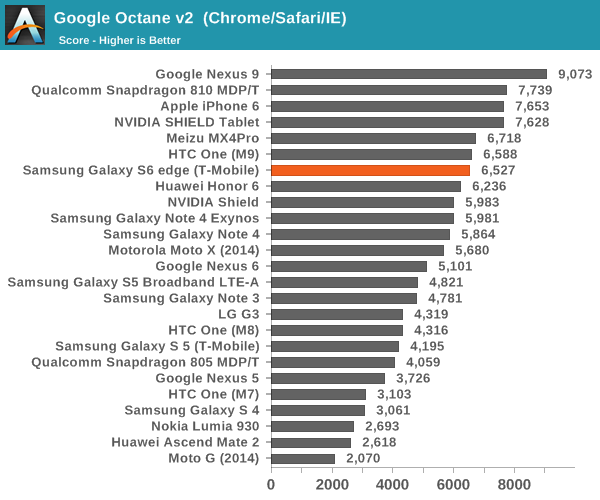
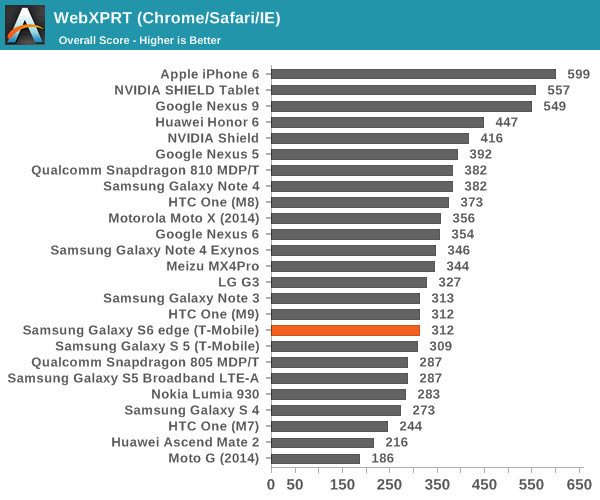
The Exynos 7420 is about on par with the Snapdragon 810 in these benchmarks. Strangely enough both tend to do worse than the Huawei Honor 6 in these tests, which clearly can't be correct. As we've previously discussed, the stock browser will often give far better results due to OEM and SoC vendor optimizations. As a part of our updates to the benchmark suite for 2015, we'll take a look at Basemark OS II 2.0, which should give a better picture of CPU performance in addition to overall device performance.
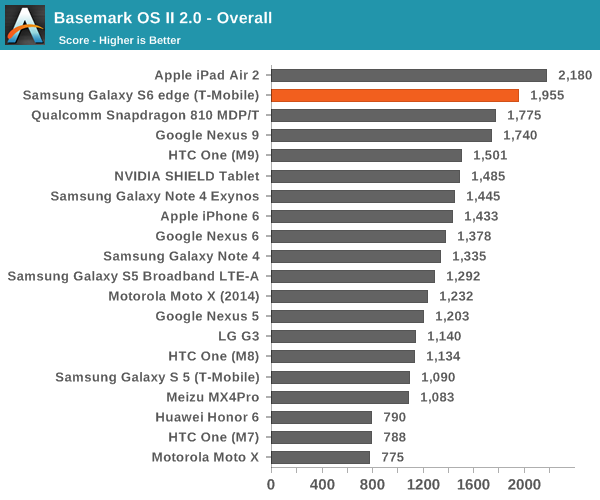
The browser benchmarks seem to hide some pretty enormous variability as the Galaxy S 6 edge (which is comparable to the Galaxy S 6) sets a new record among Android devices. The only challenger is the iPad Air 2, which uses the A8X SoC with three Enhanced Cyclone cores and the semi-custom GXA6850 GPU.

This system test contains a floating point and integer test, in addition XML parsing, which means that this test mostly stresses CPU and RAM. Interestingly enough, the Exynos 7420 pulls far ahead of both the Exynos 5433 and Snapdragon 810 in this test, and approaches the A8X. The difference between the 5433 and 7420 is likely a combination of the higher clocks on both the A57 and A53 clusters for the 7420 (1.9/1.3 on the 5433, 2.1/1.5 on the 7420), in addition to the ability to stay at a high 'overdrive' clock due to reduced leakage from the 14LPE process. The One M9 likely falls a bit short here due to HTC's governor settings restricting the use of all 8 cores simultaneously.
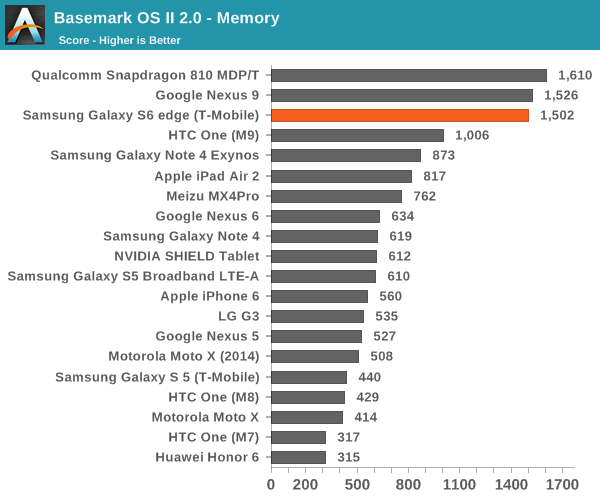
While one might guess that the memory test of 'Basemark OS II 2.0 - Memory' is of RAM, this is actually a test of the internal storage. Once again we see the S6 edge come close to leading the pack due to the use of the new UFS (Universal Flash Storage) standard. Casual examination reveals that the S6 edge has a queue depth of 16, and that it identifies itself with the rather cryptic model name of KLUBG4G1BD-E0B1.
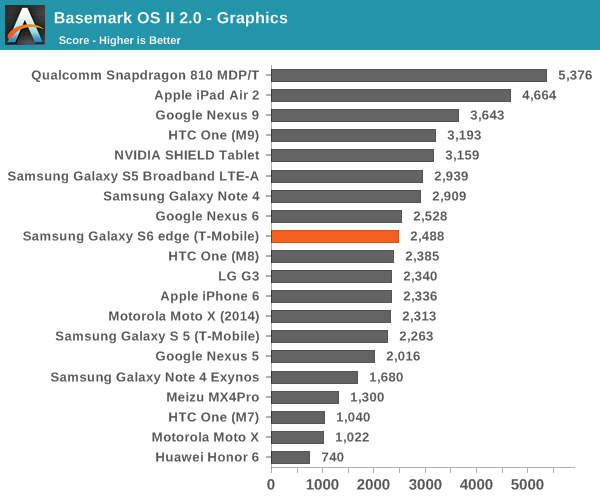

For the web test, it uses the built-in WebView rendering engine rather than Chrome and paints a distinctly different picture, especially because these tests are focused on HTML5 and CSS rather than JavaScript. Here we can see that the iPhone 6 and iPad Air 2 continue to hold their lead, but the Galaxy S6 is pretty much the king of the hill when it comes to Android devices.










200 Comments
View All Comments
cknobman - Thursday, March 26, 2015 - link
Higher resolution screen.More RAM
Smaller non removable battery
I'm scared to see the battery life benchmarks.
For me the performance does not seem that great. Its OK but not class leading necessarily.
Battery degradation is my main concern. My wifes S5 battery was so bad after 1.5 years it would not last 3 hours. At least with the S5 we could easily buy a replacement and get her phone back to lasting a day without a charge.
This new S6 means users will be screwed when the battery goes bad.
cknobman - Thursday, March 26, 2015 - link
I meantt S4 for my wifes phone, sorry typo.blanarahul - Thursday, March 26, 2015 - link
Impressed so far. But like you said I am worried about battery life. Samsung has usually done well in this regard but I am still quite skeptical. After all, the best SoC and display are useless if the phone doesn't last even 1 day of moderate use 1 year down the line. We really need more companies to follow THL, Motorola's lead and put very large batteries in phones.lilmoe - Thursday, March 26, 2015 - link
People need to put into account that Android 5.0.x is significantly worst in battery life than 4.4.x. It's only being fixed in 5.1.They'll have to do another battery test for the GS5 with the Lollipop update then compare it to the GS6.
That said, I'm hearing that Nexus devices are getting anywhere between 20-50% more battery life with 5.1 with different use cases. So I believe it's save to assume that the GS6 will get better in a couple of months when it gets the update.
robertkoa - Thursday, March 26, 2015 - link
Honestly I doubt if the Physics and heat created ( wasted energy) by all the Pixels will be overcome by Software.And we haven't seen the real world on a Network usage reports from users yet which are always lower SOTs than web scripts and Tests.
It's thin and beautiful and a little underpowered like Alpha was...
Some of us need thicker Note-like 8mm thick devices but in various screen sizes like Note 5 and Note 5 Compact.
To me 8mm can still be beautiful especially with a 4.7" screen and 3000 Mah Battery.
No miracles at 6.7mm or 6.8mm thin AND the Camera is protruding too far IMO ...fragile.
Still Samsung did extremely well on these and will sell huge and if the Camera is great I may even get one lol.
lilmoe - Friday, March 27, 2015 - link
I'm not one of the supporters of unnecessarily huge resolutions on screens that small. The GS6's hardware as a whole is faster and more power efficient than the GS5, but yes, i believe it would have been even faster, more fluid and more power efficient if they stuck with 1080p on that higher quality, more power efficient panel.That said, it's undeniable that software plays a huge role in battery life. That's a fact. So, i believe we need to be fair in our comparisons.
blue_urban_sky - Friday, March 27, 2015 - link
It just struck me and I'm probably wrong but if you have a brightness level / area then the power requirement is separate to the number of pixels you have. The difference then would be the power to drive the computing needed put things on the display and that would be effected by software.gyrocoptic - Friday, March 27, 2015 - link
You are not wrong. For some reason people seem to believe that 100 x 10W light bulbs use more power than 10 x 100W light bulbs. The S6 display is actually more energy efficient than the S5 display at the same brightness. The only battery concern would be that the GPU has to render a higher resolution image if, and only if, a game supports 2k resolution AND at the same frame rate. This is a highly unlikely scenario. In normal use the S6 will provide the best display ever seen on a smartphone at a power consumption equal to or less than that of the S5.lilmoe - Friday, March 27, 2015 - link
This perception that only games rendered at 1440p affect performance and battery life is very far from the truth. Even the simplest things as text and UI rendering at unnecessarily high resolutions have a dramatic effect, not to mention Web browsing.To make it short, take a look at the Dell XPS 13 review and look at the dramatic difference in battery life between both SKUs. Smartphones are basically computers with GSM modems. I don't see how the same won't apply.
The GPU is NOT the only part doing extra work, the platform as a whole takes quite a significant hit.
jospoortvliet - Sunday, March 29, 2015 - link
With LCD higher resolutions make it harder to reach the same brightness due to more circuitry blocking light. This harms the DELL XPS 13. I am not sure if this is the case with amoled - it has no backlight but pixels give light by themselves. It might very well not Make a difference so the battery impact will be far less than on LCD.